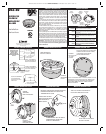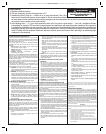
Copyright © 2009 Linear LLC 227112 D
1.0 WHAT YOU SHOULD KNOW ABOUT CO
Carbon monoxide (CO) is an insidious poison. It is a colorless, odorless
and tasteless gas. It is a cumulative poison. Even low levels of CO have
been shown to cause brain and other vital organ damage in unborn
infants with no effect on the mother.
The following symptoms are related to CARBON MONOXIDE
POISONING and should be discussed with ALL members of the
household:
MILD • EXPOSURE: Slight headache, nausea, vomiting, fatigue
(often described as “flu–like” symptoms)
MEDIUM • EXPOSURE Severe throbbing headache, drowsiness,
confusion, fast heart rate
EXTREME • EXPOSURE Unconsciousness, convulsions,
cardiorespiratory failure, death
Many cases of reported CARBON MONOXIDE POISONING indicate
that while victims are aware they are not well, they become so
disoriented they are unable to save themselves by either exiting the
building or calling for assistance. Also, young children and household
pets may be the first affected.
Your CO alarm is designed to detect the toxic CO fumes that result
from incomplete combustion, such as those emitted from appliances,
furnaces, fireplaces and auto exhaust.
A CO Alarm is NOT A SUBSTITUTE for other combustible gas, fire
or smoke alarms. This carbon monoxide alarm is designed to detect
carbon monoxide gas from ANY source of combustion.
CAUTION: ☞ This alarm will only indicate the presence of
carbon monoxide gas at the sensor. Carbon monoxide gas
may be present in other areas.
WARNING: ★ This product is intended for use in ordinary
indoor locations of family living units. It is not designed to
measure compliance with Occupational Safety and Health
Administration (OSHA) commercial or industrial standards.
Individuals with medical problems may consider using
warning devices which provide audible and visual signals
for carbon monoxide concentrations under 30 ppm.
2.0 IMPORTANT CONSIDERATIONS
2.1 • The DXS-80 has been designed to operate for six years with
regular maintenance.
2.2 • Never disconnect the battery to silence an alarm. The alarm will
automatically sense when the level of CO in the air falls below the
danger level. You should stay outside the residence in fresh air until
the alarm is silenced. When the alarm sounds, do not stand too close
to the alarm. The sound produced by the alarm is loud because it is
designed to awaken a person in an emergency. Prolonged exposure
to the alarm at a close distance may be harmful to your hearing.
NOTE: ☞ Manufacturer strongly recommends replacement
of alarm six years after date of purchase. Under no
circumstances should the alarm be used (7) years after the
date of purchase.
3.0 DEVELOPING YOUR OWN CO SAFETY PLAN
This CO alarm can quickly alert you to the presence of CO, it cannot
prevent toxic CO emissions. Please note that there are hazards
against which CO detection may not be effective, such as gas leaks or
explosions. The ultimate responsibility for protection against toxic CO
fumes rests solely on you.
Installing CO detectors is just the first step in protecting your family
from toxic CO poisoning. We also suggest that you create an effective,
comprehensive safety program as outlined below.
3.1 • Install CO detectors properly following the instructions in this
manual.
3.2 • Develop a family escape plan and practice it with your entire
family, especially small children.
IMPORTANT INFORMATION
Draw a floor plan of your home and find two ways to exit from ✓
each room. There should be one way to get out of each bedroom
without opening the door.
Make sure that all occupants know what the CO alarm signal ✓
means and how they must exit the residence by themselves if
necessary.
Decide on a meeting place a safe distance from your house and ✓
make sure all occupants understand where they should go and
wait if there is a dangerous CO condition.
Conduct CO safety drills at least every 6 months to make sure ✓
that everyone, even small children, know what to do in order to
escape safely.
Know where to go to call the Fire Department from outside your ✓
residence.
NOTE: ☞ This unit is designed to detect carbon monoxide
(CO) entering its sensing chamber. It does not sense
combustible gas (such as natural gas, propane or butane),
heat, smoke or flames.
4.0 IMPORTANT: WHAT YOUR CO ALARM CAN AND
CANNOT DO
4.1 • This CO alarm is designed for use within a single residential
living unit only. In a multi-family building, the alarm may not provide
early warning for residents if it is placed outside of the residential
units, such as on outside porches, in corridors, lobbies, basements,
or in other apartments. In multi-family buildings, each residential unit
should have detectors installed as previously indicated.
4.2 • When properly located, installed, and maintained, this CO alarm
is designed to provide early warning of developing poisonous CO
conditions at a reasonable cost. This alarm monitors the air, and
when it senses CO, it activates its built-in alarm. It can provide
precious time for you and your family to escape from your residence
before CO can seriously injure or kill. However, such an early warning
is possible only if the alarm is located, installed, and maintained as
specified in the Owner’s Manual.
WARNING: ★ The DXS-80 CO Alarm is not designed for
marine, aircraft, automobile or RV use.
5.0 INSTALLING THE DXS-80 FOR RESIDENTIAL USE
If bedroom doors are usually closed at night, alarms should be placed
in each bedroom as well as in the common hallway between them. CO
alarms may not sense CO on a different level of a residence or building.
For example, a second floor alarm may not sense a CO leak on the first
floor or in the basement.
Therefore, alarms should be placed on every level of a residence or
building. If the alarm is located outside of a bedroom, it may not wake
up a sound sleeper, especially if the bedroom door is closed or only
partly open. If the alarm is located on a different level of the residence
than the bedrooms, it is even less likely to wake up people sleeping in
the bedroom.
Installing CO alarms may qualify you for lower homeowner’s insurance
rates, but CO alarms are not a substitute for insurance. Homeowners
and renters should continue to insure their lives and property.
5.1 • RECOMMENDATIONS One of the most important considerations
in any CO alarm system is the location of the alarms. Statistics of
the National Fire Protection Association (NFPA) show that most of
the fatal CO occurrences happen at night while people are sleeping.
Early warning of CO is best achieved by the correct installation of
CO alarms. Placement of an alarm in a garage may cause an alarm
due to CO from automotive exhaust.
5.2 • RECOMMENDED MOUNTING LOCATIONS Put a CO alarm
inside each bedroom where the occupant closes the door while
sleeping. A closed door can block particulate smoke, but CO gas
is likely to get through.
5.3 • This CO alarm must be mounted on the wall or ceiling.
5.4 • LOCATIONS TO AVOID Placing units where they will not operate
properly causes nuisance alarms. To avoid nuisance alarms, do not
place units:
Within 5 feet (1.5m) of any cooking appliance or furnace. ✓
Near an open window or door, because the fresh air entering the ✓
opening may delay CO from reaching the alarm.
In damp or very humid areas or next to bathrooms with showers ✓
or tubs. Install detectors at least 10 feet (3 meters) away from
bathrooms.
In very cold or very hot environments or in unheated buildings ✓
or outdoor rooms where the temperature can go below or above
the operating range of the alarm. Temperature limits for proper
operation are 32° F to 100° F (4.4° C to 37.8° C).
Good ventilation is recommended when household cleaning ✓
supplies or similar contaminants are used.
5.5 • SOME CONDITIONS WHICH CAN RESULT IN TEMPORARY
CO SITUATIONS:
5.5.1 • Excessive spillage or reverse venting of fuel burning
appliances caused by outdoor ambient conditions, such
as:
a. Wind direction and/or velocity, including high gusts of wind.
Heavy air in the vent pipes (cold/humid air with extended periods
between cycles).
b. Negative pressure differential resulting from the use of exhaust
fans.
c. Simultaneous operation of several fuel burning appliances
competing for limited internal air.
d. Vent pipe connections vibrating loose from clothes dryers,
furnaces, or water heaters.
e. Obstructions in or unconventional vent pipe designs which can
amplify the above situations.
5.5.2 • Extended operation of unvented fuel burning
devices (range, oven, fireplace, etc.)
5.5.3 • Temperature inversions, which can trap exhaust
gasses near the ground.
5.5.4 • Car idling in an open or closed area garage, or near
a home.
This device complies with FCC Rules Part 15. Operation is subject to the following
two conditions: (1) This device may not cause harmful interference, and (2) This
device must accept any interference received, including interference that may cause
undesired operation
LINEAR LIMITED WARRANTY
This Linear product is warranted against defects in material and workmanship for
twenty-four (24) months. This warranty extends only to wholesale customers who
buy direct from Linear or through Linear’s normal distribution channels. Linear does
not warrant this product to consumers. Consumers should inquire from their selling
dealer as to the nature of the dealer’s warranty, if any. There are no obligations or
liabilities on the part of Linear LLC for consequential damages arising out of or
in connection with use or performance of this product or other indirect damages
with respect to loss of property, revenue, or profit, or cost of removal, installation,
or reinstallation. All implied warranties, including implied warranties for merchantability
and implied warranties for fitness, are valid only until warranty expires. This Linear LLC
Warranty is in lieu of all other warranties express or implied.
All products returned for warranty service require a Return Product Authorization
Number (RPA#). Contact Linear Technical Services at 1-800-421-1587 for an RPA#
and other important details
IMPORTANT!!!
Linear radio controls provide a reliable communications link and fill an important need
in portable wireless signaling. However, there are some limitations which must be
observed.
V For U.S. installations only: The radios are required to comply with FCC Rules
and Regulations as Part 15 devices. As such, they have limited transmitter
power and therefore limited range.
V A receiver cannot respond to more than one transmitted signal at a time
and may be blocked by radio signals that occur on or near their operating
frequencies, regardless of code settings.
V Changes or modifications to the device may void FCC compliance.
V Infrequently used radio links should be tested regularly to protect against
undetected interference or fault.
V A general knowledge of radio and its vagaries should be gained prior to acting
as a wholesale distributor or dealer, and these facts should be communicated
to the ultimate users.
PRINTERS INSTRUCTIONS
INSTR,INSTL,DXS-80 - P/N: 227112 D - INK: BLACK - MATERIAL: 20 LB. MEAD BOND - SIZE: 8.500” X 11.000” - SCALE: 1-1 - SIDE 2 of 2
WARNING
ACTUATION OF YOUR CO ALARM INDICATES THE
PRESENCE OF CARBON MONOXIDE (CO),
WHICH CAN KILL YOU!
If alarm sounds:
1 Operate reset/silence button
2 Call your emergency services fire department or 911
3 Immediately move to fresh air – outdoors or by an open door/window. Then, do a
head count to check that all persons are accounted for. Do not reenter the premises
nor move away from the open door/window until the emergency services responders have arrived, the premises have been aired
out, and your alarm remains in its normal condition.
4 After following steps 1 - 3, if your alarm reactivates within a 24-hour period, repeat steps 1 - 3 and call a qualified technician
to investigate for sources of CO from fuel burning equipment and appliances, and inspect for proper operation of this equipment.
If problems are identified during this inspection, have the equipment serviced immediately. Note any combustion equipment not
inspected by the technician and consult the manufacturers’ instructions or contact the manufacturers directly for more information
about CO safety and this equipment. Make sure that motor vehicles are not and have not been operating in an attached garage
or adjacent to the residence.




